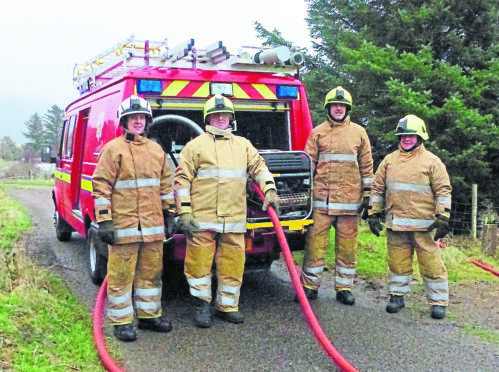Firefighters across the world are known for their close ties – but one unit on the Ardnamurchan peninsula are much closer than most because they are members of the same family.
The retained unit in Kilchoan, with a population of just 150, until recently comprised watch manager Rosie Curtis, her husband David, brother Hugh and her sister Nan.
In many retained units across the Highlands it is not uncommon to find people who know each other outside the station and then serve together but having so many family members is a rarity.
But the family make-up of the Kilchoan unit does not detract from their roles according to Mrs Curtis, who was recently awarded the Queen’s Fire Service Medal for her dedication.
She said: “It is good to have family around you when working, but when the pager goes, you are a firefighter above anything else.
“We all know what we have to do and have a clear chain of command. We are a family, a close one, but when the pager goes, we are professionals – and get on with it.”
But now with her sister already retired and both her husband and brother considering hanging up their helmets too there is a need to recruit new members – and where better to look than her own three children?
With Mum and Dad thinking about taking it a little easier it could soon be time for the Curtis children to pick up the gauntlet – though they are still a little young: Chloe, 13, Megan, 12 and Allan, 7.
But Mrs Curtis revealed they would be well-prepared, saying: “All three know that when the pager goes their mum and dad are going to help someone – hopefully we rub off on them and we get at least one joining the service.
“They’ve never known a life outside of the Fire Service – we’ve been in the Service since they were babies, so they’re well used to it.”
She added: “Allan wants to be a firefighter when he’s older and asks a lot of questions about the Service. He likes to come along to the station with me and is very inquisitive.”
The need for young people to protect rural communities is not lost on Mrs Curtis after more than 20 years of service and she is now appealing to the next generation of retained fire fighters to follow in her footsteps.
She said: “We need young people to come in to our communities and to help. Myself and David have already said to our own kids that we won’t be able to keep it going forever – young people are the future.
“Communities like our own rely on people serving as fire fighters, and as emergency service workers – it’s so important.”
Retained firefighters face rigorous selection and training regimen
The Retained Duty System means the fire service is able to man stations across the country, particularly rural areas, providing wider coverage than if officers had to be deployed full time.
Typically retained fire fighters are “on call” while working at their usual place of employment, which if there was a fire they would have to leave.
But despite them being essentially part-time retained fire fighters are just as capable of providing the same range of emergency services as their full time colleagues.
Selection is demanding and rigorous for those willing to apply.
In the past six months, the fire service received around 1,500 applications from men and women across the country – although of those 1,500 applications, only 82 completed training.
Some of the demands are particular to the “retained” role, such as candidates must live or work within a 5 – 8 minute journey of the station so that response times are as short as possible.
They must also be willing respond to emergency calls at the drop of a hat from home or work at any time of the day or night and have advance permission of their employer to do so.
The demands placed on retained fire fighters can be just as high as those operating full time.
Due to that prospective fire fighters must be willing to commit to the full recruitment process, including practical selection tests such as confined spaces and fitness tests.
Additionally they must be fully committed to the service within the community and available to attend a two to three hour training session one night a week.










